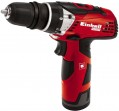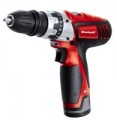Rotation speed
The speed of rotation of the working nozzle provided by the tool.
If a single number is indicated in this paragraph (for example, 1800), it can be either a standard, constant, or maximum rotation speed. This refers to the maximum speed if the tool has more than one speed (see "Number of speeds") and/or a speed controller (see "Functions"). In turn, two or three numbers through an oblique line (for example, 1100/2300/3400) are indicated only for models that have the corresponding number of individual speeds. Each of these numbers indicates the standard (and in the presence of a speed controller — the maximum) number of revolutions at one of the speeds.
Anyway, when choosing a tool by the number of revolutions, it is worth considering both its general type (see "Device") and the specifics of the intended work. Detailed recommendations on this matter are quite extensive, it makes no sense to give them in full here — it is better to turn to special sources. We note only a few general points. So,
high -speed drills nowadays are considered to be drills capable of delivering more than 3000 rpm. In general, high speed contributes to productivity, but there is also a downside: increasing the speed (for the same power) reduces torque — accordingly, the efficiency of working with stubborn materials and large diameter nozzles decreases. Therefore, it makes sense to specifically look for a "high-speed" tool only if speed is of key impor
...tance; it doesn’t hurt to make sure that the model you choose can provide the required efficiency and torque.Torque
Torque is the maximum force with which this model is capable of turning the working nozzle.
Higher torque gives more options, it allows you to cope with complex tasks such as drilling in hard materials, unscrewing stuck screws and nuts, etc. On the other hand, a lot of force requires corresponding power — and this, in turn, affects the dimensions , weight and cost of the tool itself, and also puts forward increased power requirements (mains power, battery capacity or pressure / compressor performance). And for some tasks, excessive torque is basically unacceptable, so for maximum versatility, it is desirable to have
torque control — and this affects the cost even more. And the more steps, the more optimally you can configure the tool to perform a particular type of work. So the general rule is this: when choosing, it is worth considering the specifics of the planned work, and not chasing the greatest working effort.
Detailed recommendations on choosing the optimal torque for different types of tools (see "Device") can be found in special sources. Here we note that it is of key importance primarily for screwdrivers, although it is also given for other types of tools. At the same time, in the “weakest” models, the maximum working force does not exceed 15 Nm, in the most powerful ones it is more than 150 Nm.
Weight
The total weight of the tool is usually the device itself, without attachments. For battery models (see "Power Source"), usually, the weight is indicated with a standard battery installed; for battery-powered models, the weight can be given both with and without batteries, but in this case this point is not particularly important.
Other things being equal, less weight simplifies work, increases accuracy of movement and allows you to use the tool for longer without tiring. However, note that high power and productivity inevitably increase the mass of the tool; and various tricks to reduce weight increase the price and can reduce reliability. In addition, in some cases, a massive design is more preferable. First of all, this applies to work with a large load — for example, drilling holes of large diameter, or making recesses with impact: a heavy tool is more stable, it is less prone to jerks and shifts due to uneven material, vibration of mechanisms, etc.
It is also worth noting that specific weight values are directly related to the type of tool (see "Device"). Screwdrivers are the lightest — in most of them this figure
does not exceed 500 g. Screwdrivers and drill drivers are more "heavy": their average weight is
1.1 – 1.5 kg, although there are many lighter (
0.6 – 1 kg) and heavier (
1.6 – 2 kg or more ) models. And clas
...sic drills and wrenches have the greatest weight: such a tool must be quite powerful, so for them 1.6 – 2 kg is an average, 2.1 – 2.5 kg is above average, and many units weigh more than 2, 5 kg.Battery in set
The number of batteries supplied with the respective tool (see "Power Source"). Also, this paragraph may indicate the presence of a
built-in battery.
The most popular
configuration option with a battery nowadays is
2 batteries. This provides additional benefits that are especially useful for long-term continuous use of the tool. So, when the charge of one battery is exhausted, you can quickly change it to another; while one battery is in use, the other can be charged. This minimizes or eliminates interruptions in charging. Some tools for the same reasons can be equipped with
three batteries, however, such sets are much less common, since they are more expensive and do not have fundamental advantages.
Single battery kits are also not particularly common: these are mostly entry-level tools designed for small amounts of work, when charging breaks are quite acceptable.
In addition, quite a few modern cordless tools come
without batteries. This configuration assumes that the user himself will purchase batteries at his discretion (many models are compatible with several brands of batteries at once). In addition, this option may come in handy in case the battery is already on the farm. This happens quite often, since many well-known manufacturers use universal bat
...teries suitable for different types of branded power tools. So a battery, for example, from a previously purchased jigsaw or grinder may well be compatible with a screwdriver from the same company.
As for non-removable batteries, this is a rather rare and specific option. Such tools are as compact as possible, but the batteries themselves cannot be quickly changed — so you will inevitably have to take breaks for charging during work. Therefore, this method of supply is typical for low-power tools — mainly screwdrivers (see "Device"). In them, small size is more important than a long period of continuous operation, in addition, a low capacity allows you to achieve good battery life even with small sizes (and, accordingly, capacity) of batteries.Battery capacity
The capacity of the battery supplied with the respective tool (see "Power Source"). The most modest capacity values in modern power tools
do not even reach 1 Ah, such batteries are found mainly among
electric screwdrivers(see "Device"). And in powerful professional models there are batteries for
3 – 4 Ah and even
more.
Theoretically, the higher the capacity, the longer the tool will be able to work on a single battery charge. However, in fact, things are far from being so clear cut. First, the ampere-hour is a fairly specific unit; its features are such that only batteries with the same voltage can be directly compared by the number of ampere-hours. With a difference in voltage, you need to convert the capacitance to watt-hours and use them for comparison. Secondly, the actual battery life of the tool depends not only on the properties of the battery, but also on the power consumption and other performance characteristics. Thus, it is possible to compare different models in terms of battery capacity only with the same supply voltage and similar capabilities.

